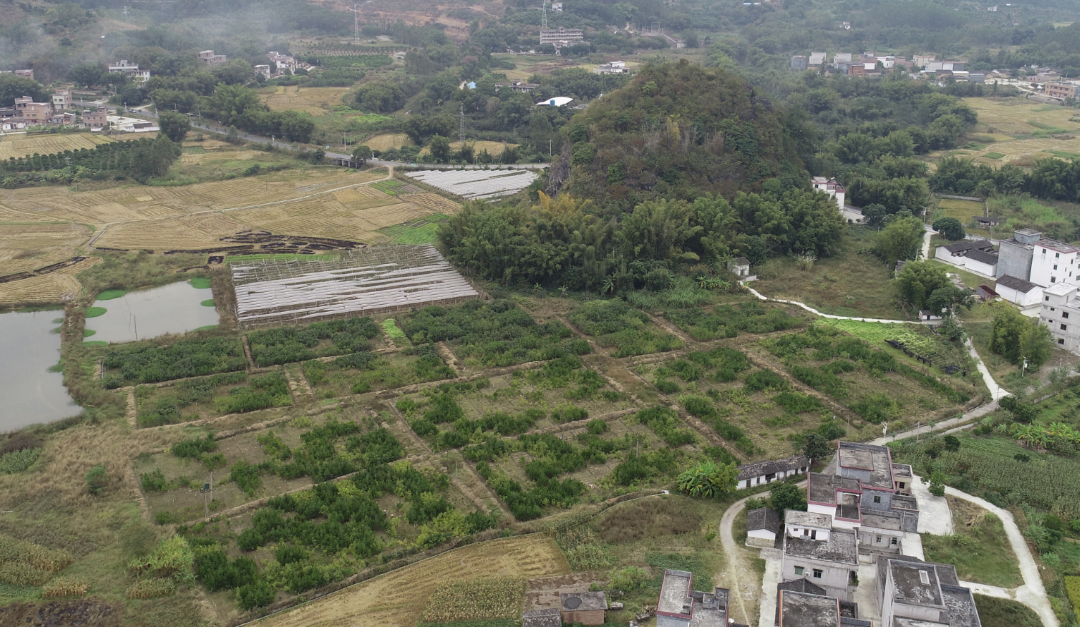CADE (China)
The CADE (Competition and Diversity Experiment) was established in January 2018, representing the tropical-subtropical forest ecotone in southern China. It contains two sub-experiments: a competition experiment, which is designed to measure the niche overlap and fitness difference between tree species, and a BEF experiment, focusing on species diversity effect on a variety of ecosystem functions. The main goal of CADE is to explore the coexistence mechanisms underlying the biodiversity-ecosystem functioning (BEF).
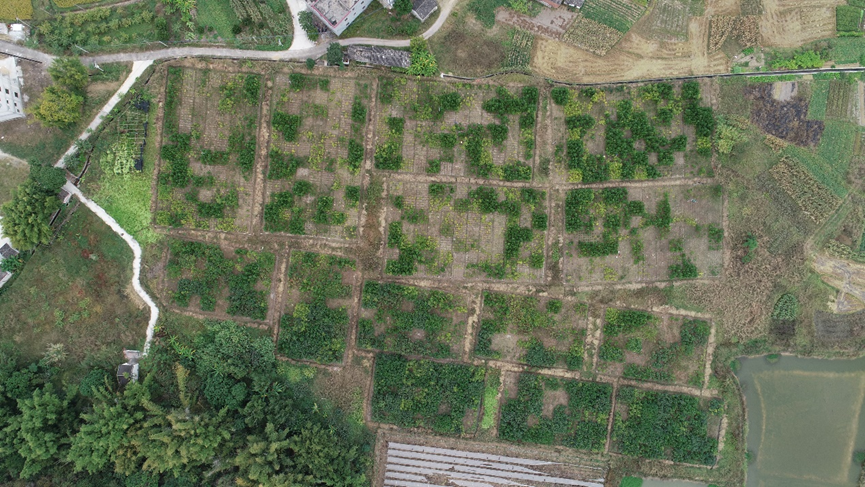
Design
Competition experiment
The Competition experiment includes 4 species and consists of 6 blocks (48 m × 28 m), with 84 plots (4 m × 4 m) in each block. Following the response surface design, every plot contains 2 species at four different densities (25, 36, 64, and 100 saplings per plot) and five abundance proportions (A: B = 1:0, 3:1, 1:1, 1:3, 0:1). The tree saplings were planted at the equal planting distance of 0.8, 0.67, 0.5, and 0.4 m in the densities of 25, 36, 64, and 100 saplings per plot, respectively.
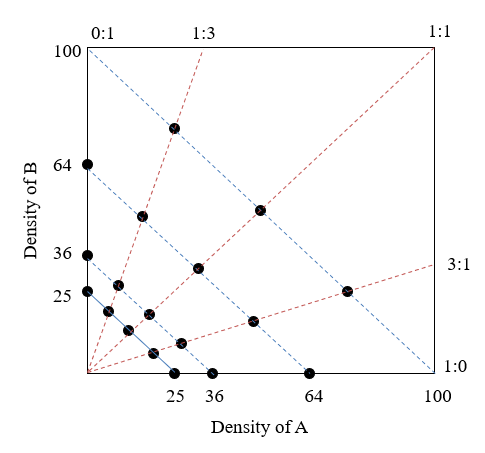
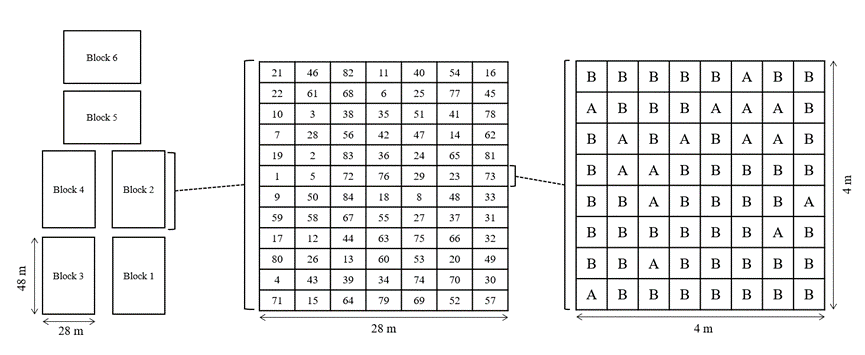
BEF experiment
The BEF experiment consists of 8 blocks (32 m × 20 m), with 40 plots (4 m × 4 m) in each block. Each plot was planted with 64 tree saplings of 1, 2, 4 or 8 species. In each block, a monoculture for each of the 8 species, 18 different 2-species mixtures, 12 different 4-species mixtures and 2 plots with all 8 species were planted. Species combinations in 2 and 4-species plots were randomly selected. The saplings were planted at an equal planting distance of 0.5 m in each plot.
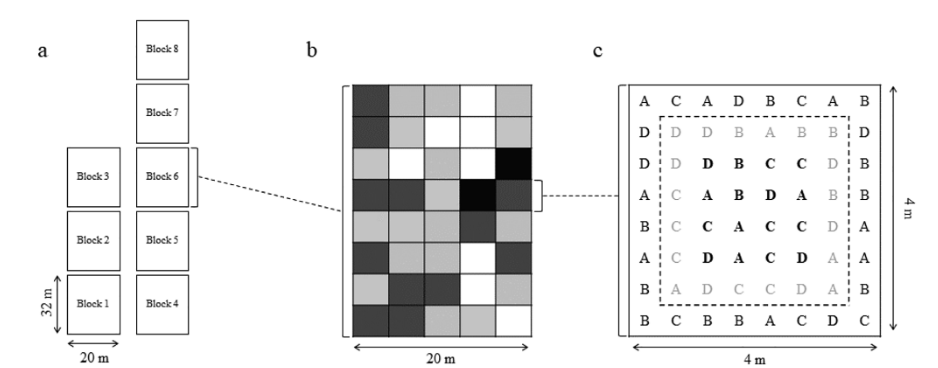
Site characteristics
| CADE-BEF (Heerkou) | CADE-Competition (Heerkou) | |
|---|---|---|
| Country | China | China |
| Biome | subtropical | subtropical |
| Latitude | 23.51 | 23.51 |
| Longitude | 111.82 | 111.82 |
| Soil type | Red Sandy Loam, Ferrosol (FAO) | Red Sandy Loam, Ferrosol (FAO) |
| Former land use | Cropland, planted with rice, peanut and vegetable | Cropland (block 1-4) and orange groves (block 5 and 6) |
| Altitude | 50 m | 50 m |
| Design | stem-wise randomisation | stem-wise randomisation |
| Plot shape | square | square |
| Plot size (m^2) | 16 m² | 16 m² |
| Plant distance (m) | 0.5 | 0.4 (100 tress/plot), 0.5 (64 tress/plot), 0.67 (36 tress/plot), 0.8 (25 tress/plot) |
| Number of trees planted | 20 480 | 27 300 |
| Planting date | 2017 | 2017 |
| Diversity variables | species richness | |
| Diversity gradient | 1, 2, 4, 8 sp. | |
| Size species pool | 8 | 4 |
| Species pool | Erythrophleum fordii Pinus massoniana Castanopsis fissa Castanopsis carlesii Schima superba Elaeocarpus sylvestris Ilex rotunda Cinnamomum camphora |
Erythrophleum fordii Pinus massoniana Castanopsis fissa Castanopsis carlesii |
| Contact person | Chengjin Chu (储诚进) | Chengjin Chu (储诚进) |
| chuchjin@mail.sysu.edu.cn | chuchjin@mail.sysu.edu.cn |
Research
The CADE was designed to answer the following questions (but not limited to, actually):
- How do neighbour competition and soil nutrient affect the growth and mortality of the trees?
- How does species diversity affect ecosystem functions, such as primary production, herbivory damage and soil microbial community structure?
- Do species coexistence determinants (niche difference and fitness difference) affect the direction and magnitude of the BEF relationships?
Extra information
For more information on the CADE, send an e-mail to the contact person or explore the publications that utilized data from this experiment.
Research papers
- Blondeel H, Guillemot J, Martin‐StPaul N, Druel A, Bilodeau‐Gauthier S, Bauhus J, … Baeten L 2024 Tree diversity reduces variability in sapling survival under drought. Journal of Ecology 112(5): 1164-1180 - https://doi.org/10.1111/1365-2745.14294
- Depauw L, De Lombaerde E, Dhiedt E, Blondeel H, Abdala-Roberts L, Auge H, Barsoum N, Bauhus J, Chu C, Damtew A, Eisenhauer N, V. Fagundes M, Ganade G, Gendreau-Berthiaume B, Godbold D, Gravel D, Guillemot J, Hajek P, Hector A, Hérault B, Jactel H, Koricheva J, Kreft H, Liu X, Mereu S, Messier C, Muys B, Nock CA, Paquette A, Parker JD, Parker WC, Paterno, GB, Perring MP, Ponette Q, Potvin C, Reich PB, Rewald B, Scherer-Lorenzen M, Schnabel F, Sousa-Silva R, Weih M, Clara Zemp D, Verheyen K, Baeten L 2024 Enhancing Tree Performance Through Species Mixing: Review of a Quarter-Century of TreeDivNet Experiments Reveals Research Gaps and Practical Insights. Current Forestry Reports - https://doi.org/10.1007/s40725-023-00208-y
- FAO 2023 Towards more resilient and diverse planted forests. Unasylva (254)74: 2031/1. Rome. https://doi. org/10.4060/cc8584en
- Messier C, Bauhus J, Sousa-Silva R, Auge H, Baeten L, Barsoum N, Bruelheide H, Caldwell B, Cavender-Bares J, Dhiedt E, Eisenhauer N, Ganade G, Gravel D, Guillemot J, Hall JS, Hector A, Hérault B, Jactel H, Koricheva J, Kreft H, Mereu S, Muys B, Nock CA, Paquette A, Parker JD, Perring MP, Ponette Q, Potvin C, Reich PB, Scherer-Lorenzen M, Schnabel F, Verheyen K, Weih M, Wollni M, Zemp DC 2021 For the sake of resilience and multifunctionality, let’s diversify planted forests! Conservation Letters e12829 - https://doi.org/10.1111/conl.12829
- Shen Z, Li Y, Chen Z, Xi N, Luo W, He Q, Liu S, Lin W, Zhu X, Fang S, Wang Y, Li B, Chu C 2020 Species identity and initial size rather than neighborhood interactions influence survival in a response-surface examination of competition. Frontiers in Plant Science 11: 1212 - https://doi.org/10.3389/fpls.2020.01212
